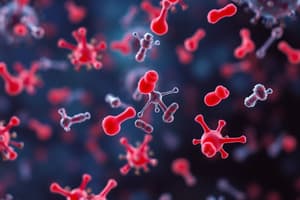Podcast
Questions and Answers
What is a primary application of immunoanalysis in disease diagnosis?
What is a primary application of immunoanalysis in disease diagnosis?
- Assessing liver function
- Measuring blood sugar levels
- Performing genetic testing
- Detecting infectious agents (correct)
Which factor is crucial for ensuring the accuracy of immunoassay results?
Which factor is crucial for ensuring the accuracy of immunoassay results?
- Number of tests performed
- Choice of statistical methods used
- Sample preparation (correct)
- Time of day the test is conducted
Which of the following is a disadvantage of immunoanalysis?
Which of the following is a disadvantage of immunoanalysis?
- High sensitivity for target detection
- Availability of multiple sample types
- Cost and complexity of antibody preparation (correct)
- Simple procedures for testing
How is automation impacting the field of immunoassays?
How is automation impacting the field of immunoassays?
What advantage does immunoanalysis have regarding the detection of target substances?
What advantage does immunoanalysis have regarding the detection of target substances?
What do competitive immunoassays measure?
What do competitive immunoassays measure?
Which immunoassay directly measures the concentration of the target analyte?
Which immunoassay directly measures the concentration of the target analyte?
What is a key application of immunofluorescence?
What is a key application of immunofluorescence?
Which technique utilizes radiolabeled antigens for detection?
Which technique utilizes radiolabeled antigens for detection?
What is the basis for the specificity observed in immunoassays?
What is the basis for the specificity observed in immunoassays?
Which method is commonly used to analyze proteins post-electrophoresis?
Which method is commonly used to analyze proteins post-electrophoresis?
What is a primary advantage of using enzyme-linked immunosorbent assays (ELISA)?
What is a primary advantage of using enzyme-linked immunosorbent assays (ELISA)?
What does immunoprecipitation primarily aim to achieve?
What does immunoprecipitation primarily aim to achieve?
Flashcards
Disease Diagnosis
Disease Diagnosis
Immunoassays are used to detect and monitor various infectious agents, including HIV and bacteria.
Hormone Measurement
Hormone Measurement
Immunoassays can measure hormone levels, which is crucial for diagnosing and managing endocrine disorders.
Drug Monitoring
Drug Monitoring
They can quantify drug levels in the body to ensure appropriate dosage and prevent toxicity.
Pregnancy Tests
Pregnancy Tests
Signup and view all the flashcards
Sample Preparation
Sample Preparation
Signup and view all the flashcards
Immunoanalysis
Immunoanalysis
Signup and view all the flashcards
Competitive Immunoassay
Competitive Immunoassay
Signup and view all the flashcards
Non-competitive Immunoassay
Non-competitive Immunoassay
Signup and view all the flashcards
ELISA (Enzyme-linked Immunosorbent Assay)
ELISA (Enzyme-linked Immunosorbent Assay)
Signup and view all the flashcards
Radioimmunoassay (RIA)
Radioimmunoassay (RIA)
Signup and view all the flashcards
Immunofluorescence
Immunofluorescence
Signup and view all the flashcards
Immunoprecipitation
Immunoprecipitation
Signup and view all the flashcards
Immunoblotting (Western Blotting)
Immunoblotting (Western Blotting)
Signup and view all the flashcards
Study Notes
Introduction to Immunoanalysis
- Immunoanalysis uses antibody-antigen interactions for detecting and quantifying substances (e.g. hormones, drugs, infectious agents) in biological samples.
- These techniques are vital laboratory tools.
Types of Immunoassays
- Competitive Immunoassays: Analyte competes with a labeled standard to bind to limited antibody. Bound label declines as analyte concentration rises.
- Non-competitive Immunoassays: Analyte binds to antibody; bound label increases with analyte concentration.
Key Techniques in Immunoanalysis
- Enzyme-linked immunosorbent assay (ELISA): A widely used technique using antibody-coated surfaces and various formats (direct, indirect, sandwich, competitive) to quantify substances.
- Radioimmunoassay (RIA): Historically used radioactive labels. Less common due to safety concerns.
- Immunofluorescence: Visualizes and measures antigens using fluorescent-labeled antibodies. Often used in microscopy and cell-based assays.
- Immunoprecipitation: Separates antigens or antibodies using specific antibodies or antigens.
- Immunoblotting (Western blotting): Separates proteins by electrophoresis, then uses antibodies to detect specific proteins.
Principles and Mechanisms
- Specificity: Antibodies bind precisely to specific antigens. This allows for detecting minute quantities in complex samples.
- Sensitivity: These assays can detect very low concentrations (e.g. critical hormones).
- Antibody-Antigen Interaction: Strong and specific binding between antibodies and antigens forms the core of these techniques.
Applications in Diagnostics
- Disease Diagnosis: Essential for identifying and monitoring infectious agents (HIV, bacteria) and autoimmune conditions.
- Hormone Measurement: Crucial for diagnosing and managing endocrine disorders.
- Drug Monitoring: Quantifies drug levels for therapeutic drug monitoring and toxicity assessment.
- Pregnancy Tests: A common example, detecting pregnancy hormones.
Factors Affecting Immunoassay Results
- Sample Preparation: Accurate sample handling is critical for reliable results.
- Reagent Quality: High-quality reagents ensure assay validity.
- Assay Procedure: Following the correct protocol maintains accuracy and reliability.
- Operator Training: Trained personnel minimizes errors and ensures consistent results.
Advantages of Immunoanalysis
- High sensitivity and specificity for target substances.
- Relatively easy implementation using various sample types (serum, plasma, urine, tissue).
- Many commercially available reagents and kits are readily available.
Disadvantages of Immunoanalysis
- Antibody preparation can be costly and challenging.
- Some procedures can be time-consuming.
Further Developments
- Research constantly improves sensitivity, specificity, and speed of immunoassays.
- Automation to increase throughput and reduce errors is ongoing.
- Point-of-care immunoassays are developing for rapid on-site diagnostics.
Studying That Suits You
Use AI to generate personalized quizzes and flashcards to suit your learning preferences.




